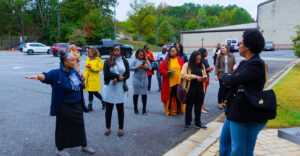We didn’t need the death of architect Helmut Jahn to bring the plight of the James R. Thompson Center to our attention. The state’s May 3 request for proposals to buy the iconic structure—minus any stipulation that it not be torn down—had already drawn widespread notice.
But the bicycle accident that killed Jahn just five days later put an exclamation point on the arguments of architects and preservationists who want to save it.
They’re asking Governor J.B. Pritzker now, as they were before Jahn’s death, to make the building’s sale contingent on its reuse, and they’re asking the city to give it the landmark designation that would protect it from demolition.
The Thompson Center is Chicago’s premier example of Jahn’s work, and the project that made him famous. Born in Germany in 1940, but a Chicagoan since coming to IIT in 1966, he’d been a Miesian modernist (working, for example, on McCormick Place’s Lakeside Center) before then-governor “Big Jim” Thompson gave the green light to this postmodernist design that put government offices atop a busy food court, shopping center, and major CTA hub, all open to the city’s most striking indoor space—a towering 17-story metal and glass atrium.
The building was controversial before it opened in May, 1985 (as the State of Illinois Center), and more so afterward. From the outside, it resembled nothing so much as a spaceship improbably plunked down (at 100 West Randolph) across the street from the classical City/County Building. Its color scheme of aqua blue and salmon pink was immediately despised. State workers complained about leaks in the glass-panel exterior, a cooling system that proved woefully inadequate for summer heat, and noise and odors wafting up from the lower-level restaurants. Jahn blamed the state for substituting inferior building materials for what he had specified, and, later, for decades of blatantly deferred maintenance.
Intended to take government from distant to literally transparent and accessible, it became a vital and diverse, if increasingly shabby, space; its spectacular atrium was the apparent inspiration for Jahn’s later, massive Sony Center in Berlin.
In 2015, Governor Bruce Rauner stood in that atrium and announced that he wanted to sell the building. He thought it could go for $300 million as a teardown, in spite of the fact that the CTA station wouldn’t be going anywhere. Rauner couldn’t get it done, however, and now, with pandemic uncertainties still hanging over the future of urban centers, and remote work taking the air out of the downtown office market, Pritzker’s talking about a profit of $200 million and touting operational savings that’ll be achieved by moving some employees to a smaller building that the state recently purchased. He hasn’t shown any interest in encumbering a potential sale with a requirement to save the unique structure.
But Landmarks Illinois’s director of advocacy, Lisa DiChiera, says that’s exactly what the state should do: “They should be putting a covenant on this building as part of its sale,” she says.
The Thompson Center was officially recognized as eligible for listing on the National Register of Historic Places in 2009, a fact that can put it on track for federal and state rehabilitation tax credits. (Federal tax credits can cover 20 percent of a rehab project’s qualifying cost, and can be layered with state tax credits.) But the state isn’t acknowledging this in its request for proposals. On the contrary, DiChiera says, the state is steering potential buyers toward demolition by “basically saying, from their perspective, the building has no historic significance and the value is in the land.”
This is deliberately misleading, DiChiera says. “Every developer that does historic rehab knows that you can be looking at historic tax credits as a potential financing tool for a major rehab project, even if the building is only deemed eligible for listing on the National Register of Historic Places and is not yet officially listed. It usually just means the developer hires a consultant to do the final nomination. It’s done all the time.”
Landmarks Illinois has already commissioned a consultant (Preservation Futures) to write the Thompson Center nomination for the National Register listing; it was submitted in April. But the best protection from demolition would come from a City of Chicago landmark designation. Last week, Preservation Chicago posted a petition at Change.org, asking the city to give the Thompson Center landmark status.
A request for city landmark designation from the governor could move that along, says Preservation Chicago executive director Ward Miller: “The Thompson Center has a great architectural legacy, and, as a public space, a great historical legacy. The state should step up to the plate.”
Chicago’s global calling card—apart from its longstanding renown as a shoot-’em-up hub of gangster activity—is its architecture. Signatures are still being collected. v







